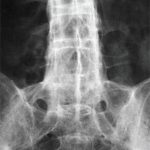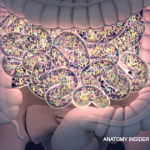I sat down at the bedside and tried to explain ankylosing spondylitis in terms of what Josh could connect with. His last year of formal schooling was 9th grade, but he had a good grasp of the basics and was open to “anything that can help.”
The hospitalization was of some benefit. On the plus side, Josh was soon able to ambulate without a cane, and the swelling in his knees, ankle, elbow and wrists improved dramatically. The first infusion of infliximab went well. His pain was better controlled; he no longer felt sedated or loopy with daytime use of hydrocodone.
But there were plenty of negatives. When he vomited up blood on Day 3, a stomach ulcer was demonstrated on endoscopy, and we needed to stop his anti-inflammatory, indomethacin. X-rays of his knees demonstrated that the cartilage was nearly gone. At age 18, he was bone on bone and looking at early bilateral knee replacement. The hips were nearly as bad. His neck and back regained zero motion. He remained stooped, lacking horizon vision, perpetually gazing at his shoe tops.
In the Long Term
I knew that we were dealing with a particularly aggressive form of AS when I saw Josh only two weeks after discharge and the fluid in his knees had recurred. Markers of inflammation—ESR and CRP—were nearly back to their prehospitalization levels. He was using a cane again. I titrated up the amount of infliximab for the next infusion and once again tapped and injected the knees.
In the ensuing weeks and months, Josh’s disease slowly came under some semblance of control. I was able to taper down the prednisone and cautiously restarted the anti-inflammatory, celecoxib, combined with omeprazole to prevent recurrence of his gastric ulcer. But Josh’s need for the hydrocodone accelerated. From time to time, he called for early refills, and on one occasion, he claimed that his pills were ruined when the top of his prescription vial came off and the pills were soaked in the rain. He missed an appointment and then another. But he always showed for his infusion of infliximab. It worked, and he knew it.
A year after our first visit, I admitted him with pneumonia, which was slow to resolve. On my way into the hospital one early morning on Day 4 of his hospitalization, I watched Josh wheel an IV pole out to the smoking area outside the hospital and light up. Confronting him, he promised he would try to quit. Out of safety concerns, I held his infliximab for a month, and the AS promptly flared. More aspirations and injections followed. Back on track with the infliximab, his disease improved, somewhat.



